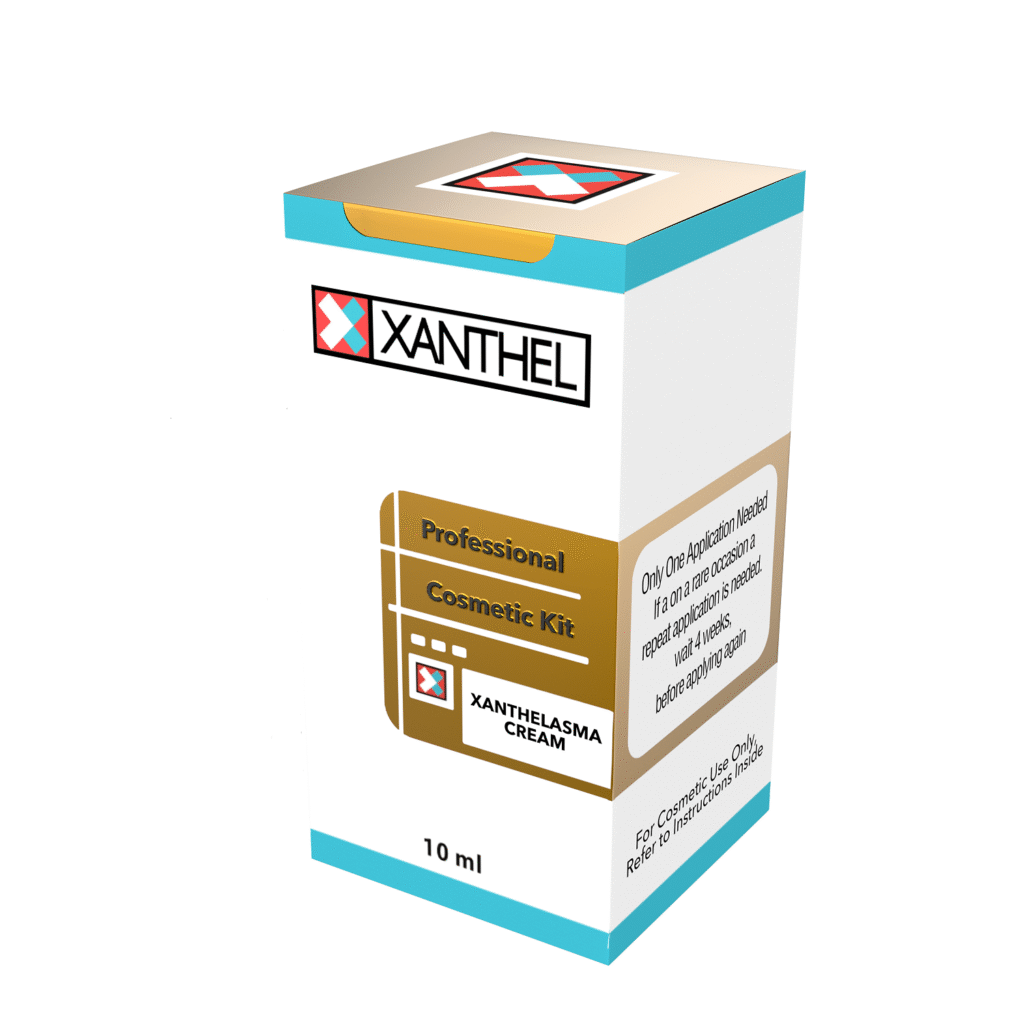Xanthelasma Palpebrarum Treatment
Definition and Characteristics of Xanthelasma
– Xanthelasma Palpebrarum: A skin condition characterized by yellowish plaques on or around the eyelids.
– Origin of Term: The word ‘xanthelasma’ combines “xanthos” (yellow) and “elesma” (plate) from ancient Greek, aptly describing the color and shape characteristics of the condition.
Key Features to Differentiate Xanthelasma from Other Conditions:
– Color: Look for the distinct yellowish tinge associated with these plaques.
– Texture: They generally have a soft, puffy, or slightly hardened texture.
– Distribution: Typically appearing symmetrically around the eyelids, particularly the inner canthus.
The Importance of Diagnosing and Treating Xanthelasma
– Cosmetic Concern: Understandably, you may find the plaques cosmetically displeasing, leading you to seek treatment for aesthetic reasons.
– Potential Indicator of Underlying Conditions:
– Lipid Disorders: Xanthelasma could be a sign of high cholesterol or other lipid imbalances.
– Diabetes: Screen for diabetes as it can be related to the occurrence of xanthelasma.
– Thyroid Dysfunction: Thyroid problems might also be associated; consider screening for it too.
Screening and Follow-up:
– Screen for Underlying Conditions: It is crucial to conduct appropriate laboratory tests for underlying lipid disorders, diabetes, and thyroid dysfunction.
– Professional Assessment: Consult with your healthcare provider for a proper evaluation that considers both cosmetic concerns and systemic health.
Treatment Options:
– Patient Preferences and Clinical Presentation: Treatment choice should be based on what you are comfortable with and your specific condition.
– Possible Treatments: Options range from surgical excision to laser therapy, Xanthel ®, and cryotherapy, among others.
– Underlying Health Conditions: If you have any systemic health issues, they need to be taken into account when choosing the treatment method.

Medical Evaluation and Diagnosis
Consulting a Treatment Professional
– Understanding Your Symptoms: It’s important to recognize the signs of xanthelasma palpebrarum. These are typically yellowish plaques that appear on the eyelids.
– Seeking Medical Advice: If you notice these changes, consult with a healthcare professional. They will evaluate the lesions, considering their color, texture, and distribution, to differentiate them from other periorbital conditions.
– Discussing Medical History: Be prepared to discuss your medical history. This includes any known lipid disorders, diabetes, or thyroid issues, as there could be a link to your xanthelasma palpebrarum.
Diagnosis Process for Xanthelasma
– Physical Examination: A careful physical examination of the eyelids will be the first step. The healthcare professional will note the size, shape, and exact location of the plaques.
– Laboratory Tests: You may undergo blood tests to screen for high cholesterol, LDL, and triglyceride levels, as well as tests for diabetes and thyroid function.
– Additional Testing: In some cases, a biopsy of the lesion may be performed to confirm the diagnosis and rule out other conditions.
Being proactive in your healthcare includes understanding the implications of xanthelasma palpebrarum. It is more than a cosmetic issue; it can sometimes be a sign of underlying health issues.
– Inquiring About Treatment Options: Different treatments are available, including surgical procedures, lasers, Xanthel ®, and cryotherapy. You should inquire about the risks, benefits, and success rates of each treatment.
– Discussing Lifestyle Changes: Regardless of the treatment chosen, discussing lifestyle changes is also critical. This may involve dietary modifications and exercise to manage lipid levels.
– Continuous Monitoring: Even after treatment, continuous monitoring of lipid levels is essential. This helps in the long-term management to prevent recurrence of xanthelasma palpebrarum.
– Coordination with Interprofessional Team: Your care should involve coordination with various healthcare professionals, such as dermatologists, endocrinologists, ophthalmologists, dieticians, and primary care providers.
Every individual’s situation is unique, and your healthcare provider will consider your preferences, clinical presentation, and underlying health conditions when selecting the most suitable treatment option. Always stay informed about your condition, participate in the decision-making process, and maintain regular follow-up appointments to ensure the best care and outcome.

Lifestyle Modifications and Natural Home Remedies ?
Lifestyle Changes for Managing Xanthelasma
– Focus on a Healthy Diet: Consuming a low-cholesterol and low-saturated fat diet can help manage your lipid levels, which is crucial in controlling xanthelasma. Include plenty of fruits, vegetables, whole grains, and lean proteins in your meals.
– Increase Physical Activity: Regular exercise can help lower bad cholesterol levels and improve overall health. Aim for at least 30 minutes of moderate intensity exercise, such as brisk walking, on most days of the week.
– Maintain a Healthy Weight: If you’re overweight, losing weight can positively affect your cholesterol levels and reduce the risk of recurrence of xanthelasma palpebrarum after treatment.
– Quit Smoking: Smoking can raise your cholesterol levels and lead to other health complications. Quitting can improve your lipid profile and benefit your overall health.
– Limit Alcohol Consumption: Excessive alcohol intake can contribute to higher cholesterol levels. It’s advisable to limit your intake in line with current health recommendations.
– Regular Screenings: Stay on top of your health by undergoing regular lipid profile screenings to monitor your cholesterol and triglycerides levels, especially if you have a history of xanthelasma.
– Stress Management: Chronic stress may influence your cholesterol levels and overall health. Techniques like meditation, yoga, and deep-breathing exercises can help manage stress effectively.
Natural Home Remedies: Do They Help?
– Garlic: Some claim that garlic can help reduce cholesterol levels. Applying garlic topically is not recommended, as it can cause more irritation and damage to the sensitive skin around your eyes.
– Castor Oil: Castor oil contains ricinoleic acid, which some believe may help reduce the appearance of xanthelasma. There is no solid research to back this up, and you should use caution to avoid getting castor oil in the eye, which can cause irritation.
– Almonds: Although almonds and other nuts can help manage cholesterol when included in your diet, there’s no scientific evidence that topical application will affect xanthelasma.
– Apple Cider Vinegar: Some people tout apple cider vinegar for various skin complaints, but once again, there’s no proof of its effectiveness for xanthelasma, and it may irritate the skin.
While some natural home remedies are suggested for the management of xanthelasma palpebrarum, it’s crucial to approach these with caution. The sensitive skin of the eyelids can be easily irritated. There is also little scientific evidence to support the effectiveness of most natural home treatment options. It’s always best to consult with your treatment provider before trying any natural home remedies, particularly around the eye area.
Remember, when it comes to managing your xanthelasma palpebrarum and associated lipid disorders, a combination of medically-approved treatments, regular monitoring, and lifestyle modifications offers the best approach for long-term health and cosmetic results. Working closely with your interprofessional healthcare team ensures cohesive and comprehensive care.

Pharmacologic Management
Medications to Manage Lipid Levels
– Understand Lipid-Lowering Drugs: Your healthcare provider might prescribe medication to manage your high cholesterol levels, which are often associated with xanthelasma palpebrarum. These medications could include statins, fibrates, niacin, or bile acid sequestrants.
– Adherence to Prescribed Regimen: It’s crucial that you adhere to the prescribed medication regimen and report any side effects to your healthcare provider. Consistency in taking your medication can have a significant impact on lowering your lipid levels and, potentially, the appearance of xanthelasma.
– Regular Lipid Profiles: Periodically, you will need to have your lipid profiles checked to assess the effectiveness of the medication and to make any necessary adjustments to the treatment plan.
– Attending Follow-up Appointments: Always keep your follow-up appointments so your healthcare team can closely monitor your cholesterol levels and the progression of xanthelasma.

Surgical Excision for Xanthelasma
The Procedure of Surgical Excision
– Consultation with a Specialist: Prior to considering surgical excision, you will be referred to a specialist, usually a dermatologist or ophthalmologist, who will evaluate your xanthelasma and discuss with you if this option is the most suitable.
– Understanding the Risks: It is essential that you understand the potential risks associated with surgery, such as infection, scarring, and changes in eyelid appearance.
– Local Anesthesia: This procedure is usually performed under local anesthesia, which means you will be awake but the area around your eyes will be numbed to prevent pain.
– Surgical Technique: The specialist will use precise surgical techniques to remove the xanthelasma plaques while trying to minimize damage to surrounding tissues and maintain eyelid function.
– Duration of Procedure: The surgery is typically quick, often taking less than an hour, but this can vary depending on the size and number of xanthelasma plaques.
– Post-Operative Instructions: Following the surgical excision, you will receive detailed post-operative care instructions which you must follow closely to ensure proper healing and minimize the risk of complications.
Expectations and Recovery from Surgery
– Immediate Aftercare: After the procedure, your eyes may be covered with bandages and you will need someone to drive you home. You should also expect some bruising and swelling in the treated areas.
– Follow-Up Visits: It’s imperative to attend scheduled follow-up visits so your healthcare provider can monitor your recovery process and address any concerns you may have.
– Managing Discomfort: If you experience any discomfort, over-the-counter pain relievers, as advised by your healthcare provider, can help manage the pain during recovery.
– Time Off Work: You may need to take several days off from work and avoid strenuous activities to allow for proper healing.
– Signs of Complications: Monitor for any signs of complications, such as excessive swelling, redness, or discharge, and immediately inform your healthcare provider if these occur.
– Patience with Healing: Remember that full healing can take a few weeks, and the final results of the surgery may not be apparent until the area has completely healed.
– Cosmetic Outcomes: While surgical excision usually offers a good cosmetic outcome, be aware that it can leave some scars, and your healthcare team will provide advice on minimizing their appearance.
In choosing surgical excision for your xanthelasma palpebrarum, your priority is to restore the natural appearance of your eyelids while addressing the condition effectively. A collaborative approach with your healthcare team and adherence to their advice will ensure the best possible outcome for both the appearance and health of your eyelids. It’s also important to consider the systemic implications of xanthelasma, such as cholesterol management, to prevent recurrence and maintain overall health.

Laser Therapy Options
Overview of Laser Treatments for Xanthelasma
When considering options for the treatment of xanthelasma, laser therapy is frequently a top choice due to its precision and minimized tissue damage. There are several types of lasers that you might discuss with your healthcare provider:
– Fractionated Erbium:YAG (Er:YAG): This type of laser is often preferred because it causes less heat damage to surrounding tissues, leading to a shorter healing time.
– Fractionated CO Lasers: Another common choice, these lasers have a proven track record of effectively removing xanthelasma plaques with minimal scarring.
– Considering Safety and Expertise: Always ensure the practitioner conducting the laser treatment is experienced with the procedure to minimize any risks of complications.
– Understanding the Process: The procedure typically involves applying a topical anesthetic followed by the laser application. Recovery time can vary, but most people experience relatively quick healing.
– Follow-up Care: Post-treatment care is critical. You may be prescribed a topical antibiotic to prevent infection and advised to avoid sun exposure which can affect healing and pigmentation.
It’s important to note that while these lasers can improve the appearance of xanthelasma plaques, they do not address the underlying high cholesterol issue. You should concurrently manage your cholesterol levels to reduce the risk of further xanthelasma development.
Comparing CO2, Pulsed Dye, and Nd: YAG Lasers
As you navigate through your options for laser treatments, it’s essential to compare the different types of lasers available:
– CO2 Lasers:
– Pros: Highly effective at vaporizing the plaques with a high level of precision.
– Cons: Slightly higher risk of scarring compared to other lasers.
– Cost: Generally more affordable compared to newer laser technologies.
– Pulsed Dye Lasers:
– Pros: Less risk of hyperpigmentation, especially in individuals with darker skin.
– Cons: May be less effective at treating deeper or thicker plaques.
– Cost: Often more expensive than CO2 lasers, depending on the region and provider.
– Nd: YAG Lasers:
– Pros: Deeper penetration can be beneficial for more pronounced lesions.
– Cons: Higher likelihood of temporary bruising and longer healing times.
– Cost: Can vary greatly; it is best to consult with providers for specific pricing.
While lasers offer many benefits, including reduced recovery time when compared to traditional surgery, they are not without drawbacks. One significant downside is the potential for recurrence, as xanthelasma often tends to reappear over time. Therefore, you should weigh the pros and cons of each laser type, considering your personal situation, skin type, and budget. Open and honest discussions with your dermatologist or a medical professional specializing in laser treatments will help guide you towards the most suitable choice. Remember, the decision is not only about aesthetic improvement. Maintaining overall health with a focus on lipid management is equally critical.

Xanthel ® Home Treatment
Utilizing Xanthel ® for Xanthelasma
As you explore various treatment options for xanthelasma palpebrarum, you may be recommended Xanthel ® removal cream as a potential at home solution. Here’s what you need to consider:
– Understanding Xanthel ®: Xanthel ® is a non-toxic formulated soltuion which, when applied to the skin, causes the xanthelasma to shrivel and disappear after application.
– Procedure: One application is needed to the affected area. Application is simple and fast and can be carried out at home by a competent adult.
– Safety Precautions: Read the enclosed treatment guidelines to make sure you get the most effective treatment possible.
– Post-Treatment Care: You must follow aftercare instructions to ensure proper healing and minimize the risk of scarring, application of an anti-bacterial cream is good practice to speed up healing of the skin.
– Recurrence and Multiple Treatments: Some patients may require multiple treatments if the treatment was not carried out following the treatment guidelines. If this is the case a second application is best carried out after 4 weeks from the intital treatment. Xanthel ® is designed to stop regrowth of the plaques.
By choosing Xanthel ®, you opt for a non-surgical treatment method that will effectively reduce the appearance of xanthelasma and remove them.

Understanding the Risks of Surgical and Laser Treatments
If you’re leaning towards surgical or laser treatments to remove xanthelasma, it’s important to assess the risks associated with these procedures:
– Surgical Excision: Though effective, surgery carries risks such as bleeding, infection, and possibly more noticeable scarring. There’s also a small chance of affecting eyelid function, which could lead to complications like ectropion.
– Laser Treatments: These generally come with a lower risk of complications compared to surgery but are not devoid of side effects. Depending on the type of laser used, you may have varying healing times, chances of skin color changes, and potential for scarring.
It’s essential to remember that different individuals may respond differently to treatment, and the complication rates remain consistent across the various modalities. The skill and experience of the professional performing the procedure play a significant role in minimizing risks.
When you are screened for xanthelasma, your healthcare provider should also check for underlying conditions such as lipid disorders, diabetes, and thyroid dysfunction, as these can influence both the occurrence of xanthelasma and the selection of treatment. Successful treatment of these underlying conditions is a crucial aspect of the management of xanthelasma palpebrarum, potentially reducing recurrence rates post-treatment. Make sure you maintain open communication with your interprofessional care team and follow their recommendations to optimize your treatment outcomes and minimize risks.





